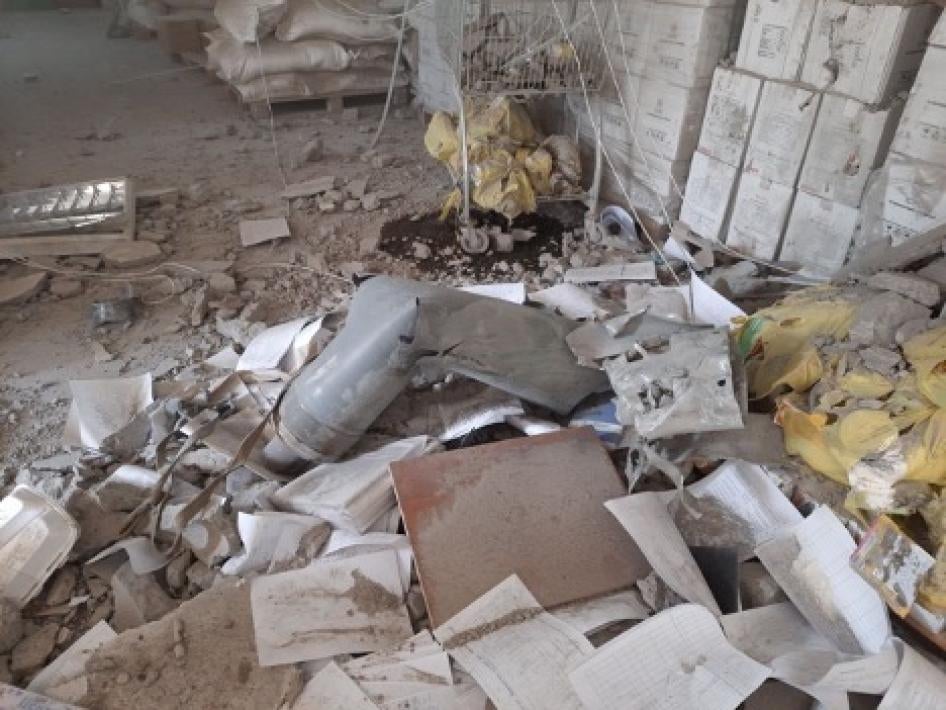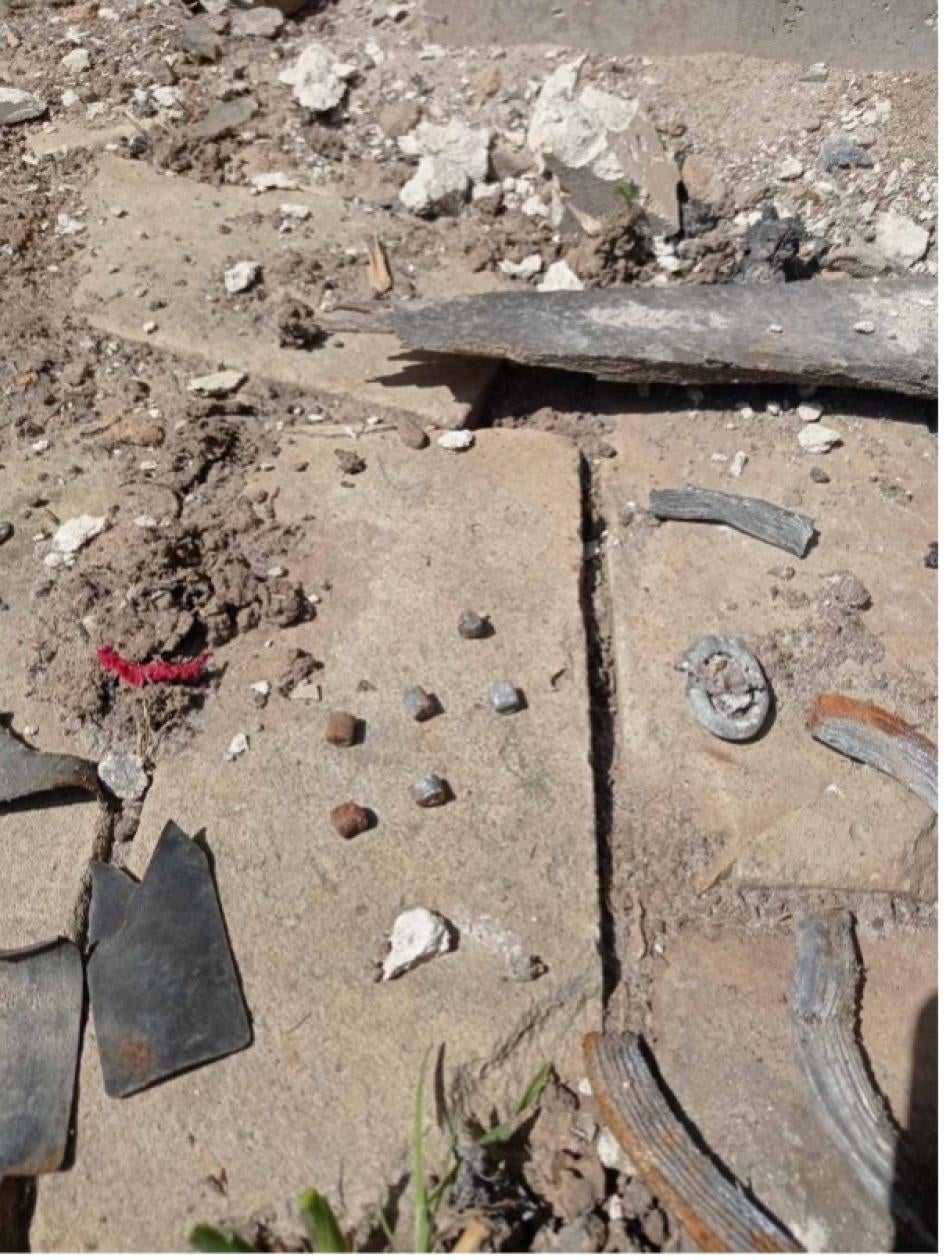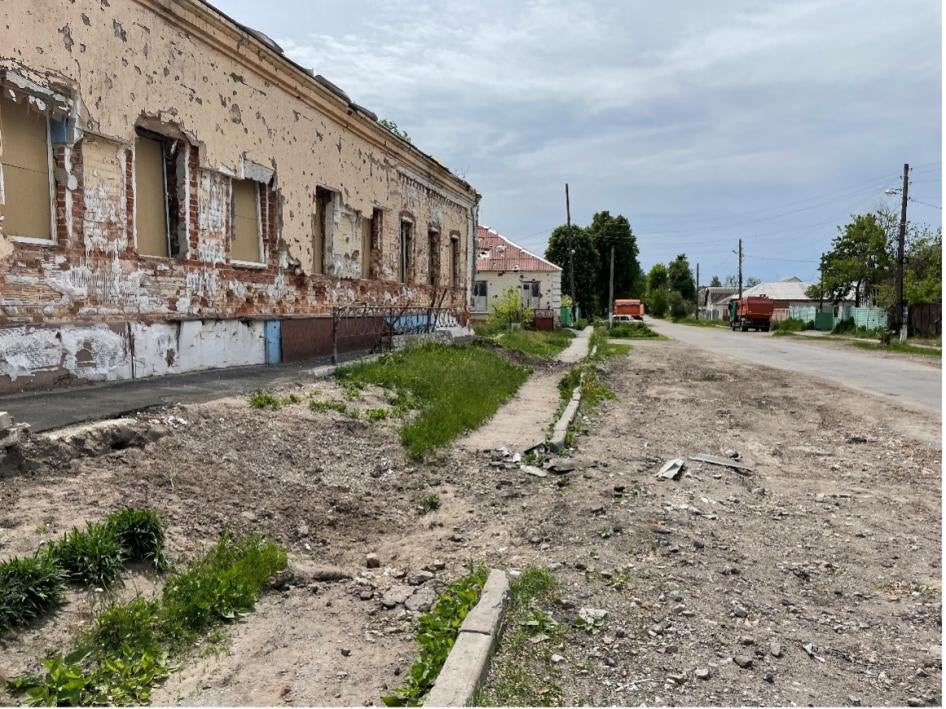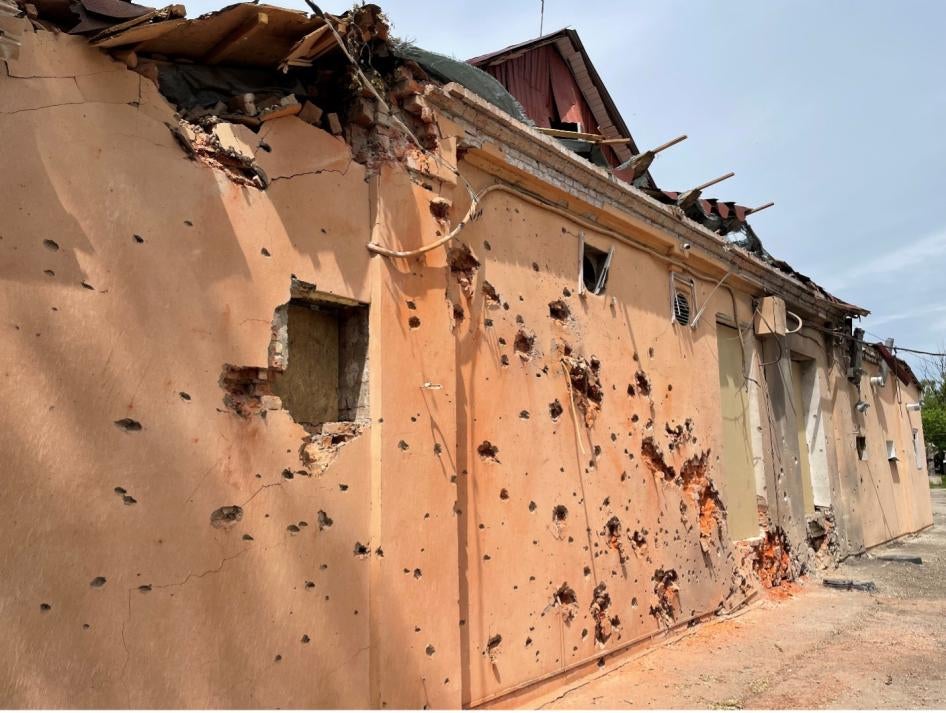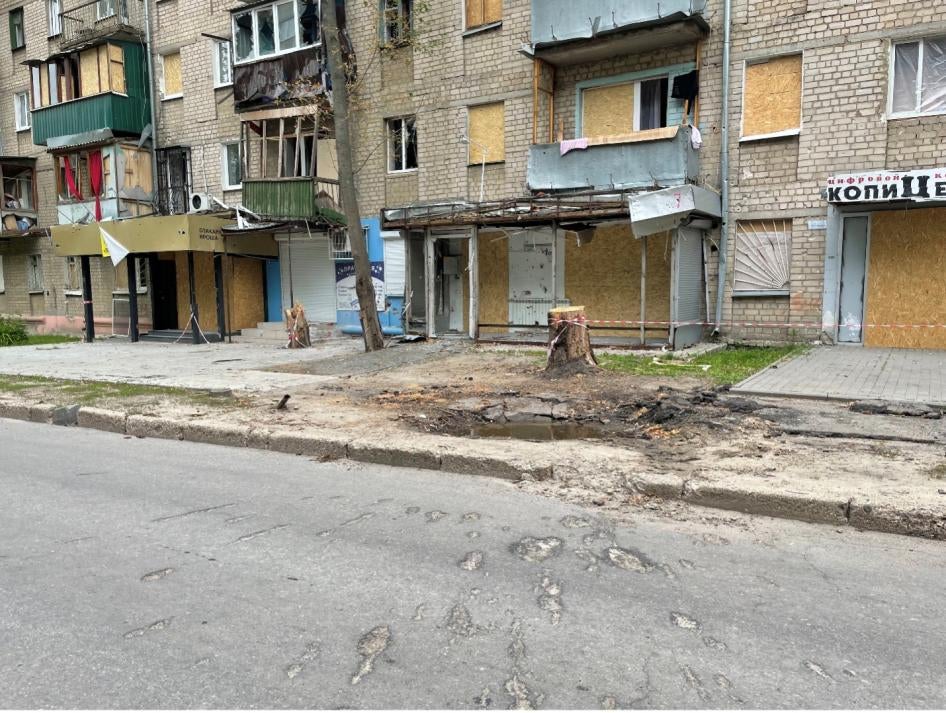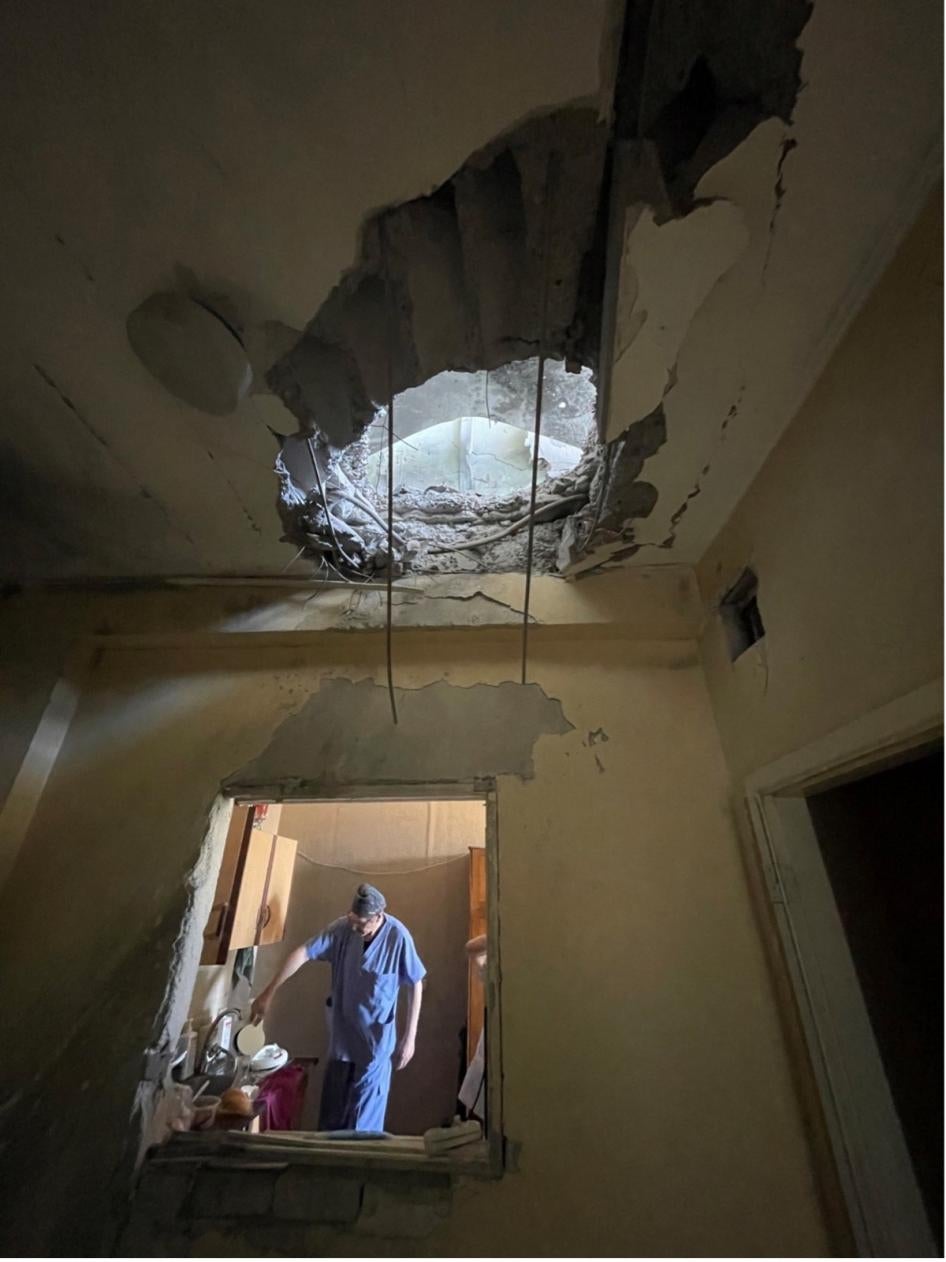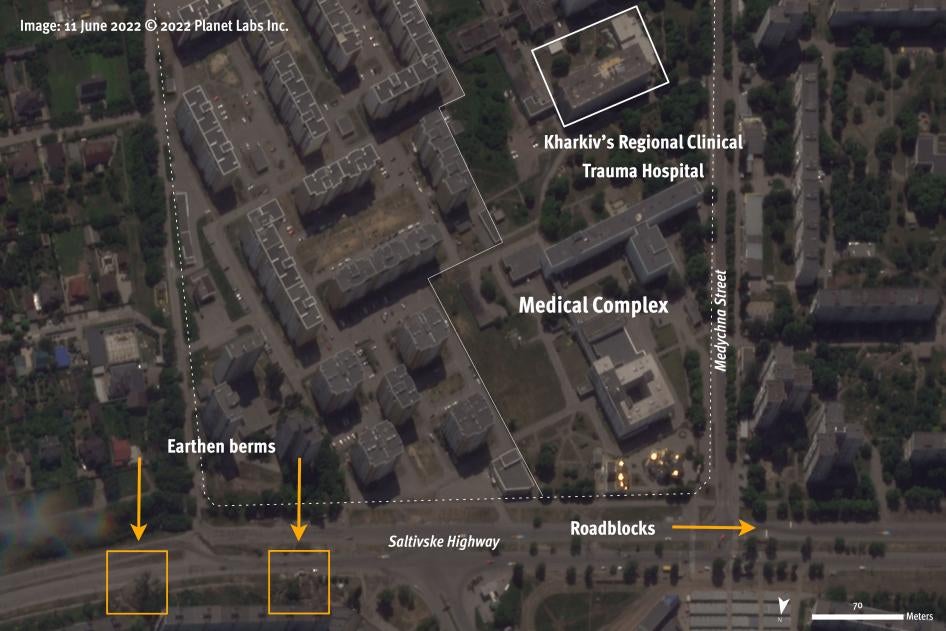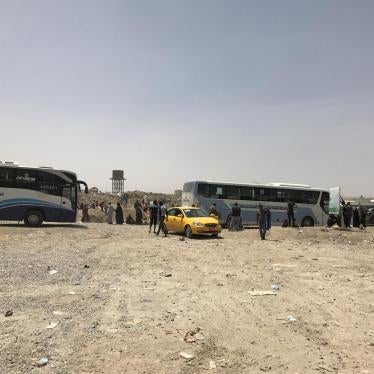(Kyiv, August 16, 2022) – Russian forces have assaulted Kharkiv, Ukraine’s second-largest city, with repeated unlawful attacks that killed and wounded civilians and damaged healthcare facilities and homes, Human Rights Watch said today. All of the attacks that Human Rights Watch documented were carried out in populated areas indiscriminately including using explosive weapons with wide area effects and widely banned cluster munitions in apparent violation of international humanitarian law, or the laws of war.
During recent visits to Kharkiv and the neighboring town of Derhachi, Human Rights Watch documented eight unlawful incidents of attacks that killed 12 civilians, wounded 26 others, and damaged at least 5 hospital buildings – just a fraction of attacks reported in the Kharkiv region since Russia’s full-scale invasion began on February 24, 2022. As well as Human Rights Watch could determine, Russian forces did not take the precautions required by the laws of war to minimize civilian harm in any of the documented attacks, three of them with cluster munitions.
“Russian forces have pummeled Kharkiv and surrounding areas, attacking densely populated residential neighborhoods with indiscriminate weapons,” said Belkis Wille, senior crisis and conflict researcher at Human Rights Watch. “In the cases we documented, Russian forces appeared to show little regard for civilian lives and the laws of war.”
According to the Kharkiv region’s deputy prosecutor, Andrii Kravchenko, at least 1,019 civilians, including 52 children, have been killed and 1,947 others wounded, including 152 children, during hundreds of attacks by Russian forces in the Kharkiv region since late February.
Between May 24 and June 28, Human Rights Watch researchers inspected the sites of eight of these cases, including three in Kharkiv and five in Derhachi, and interviewed 28 people, including 22 witnesses to the eight incidents, hospital workers, State Emergency Service representatives, and local prosecutors. Some people asked to withhold their surnames or their full names for security reasons.
Two volunteers were wounded on May 12 when a cluster munition rocket pierced the roof of a cultural center in Derhachi, where workers were preparing food and other aid for local residents. At around the same time, submunitions – possibly from the same rocket – landed in the garden of a couple who lived about a kilometer away, killing both. On May 23, a cluster munition attack struck a maternity clinic building in Kharkiv city, wounding a man at a bus stop outside the clinic building and damaging the building’s façade, windows, and pharmacy.
On May 26 a 63-year-old man taking a walk was killed when a munition landed in Kharkiv’s August 23 Square park. About a kilometer away, a woman who had just started a new job at a salon said her husband, who had come to take her home, and their 4-month-old baby boy were killed when a munition struck near the salon. The woman and a colleague were injured, and a client was also killed.
Ukraine deploys military forces inside the city of Kharkiv, but in seven of the incidents of attacks, Human Rights Watch found no evident military objective – such as armed forces, weapons, or bases or other positions – in the vicinity of the attack. In one attack that damaged a hospital, there may have been a small Ukrainian military presence nearby, but the special protections provided to medical facilities under the laws of war meant this attack was still unlawful.
All of the incidents of attacks documented were in apparent violation of the laws of war. Russian forces appear to have used munitions indiscriminately, including in three attacks with cluster munitions and three others with explosive weapons in populated areas. Five attacks damaged hospitals, including two with cluster munitions. The attacks were unlawfully indiscriminate because they were not directed at a specific military target or could not distinguish between civilians or civilian objects and military objectives.
Since February 2022, Russian forces have repeatedly used cluster munitions, which are inherently indiscriminate, in attacks across the country that have killed hundreds of civilians and damaged homes, hospitals, and schools. Ukrainian forces have used cluster munitions on at least two known occasions since the full-scale invasion began. These weapons are banned under the 2008 Convention on Cluster Munitions because of their widespread indiscriminate effect and long-lasting danger to civilians. Cluster munitions typically open in the air and send dozens, even hundreds, of small bomblets over an area the size of a football field. Many of these submunitions fail to explode on initial impact, leaving duds that act like landmines.
A State Emergency Service representative in Kharkiv said that between February 24 and May 7, the service had collected 2,700 unexploded submunitions in the city and surrounding areas.
The Russian attacks in Kharkiv demonstrate the devastating impact on civilians and civilian structures when armed forces use explosive weapons with wide area effects in populated areas, including cluster munitions, and the increased likelihood of unlawful indiscriminate and disproportionate attacks. Explosive weapons can have a large destructive radius, are inherently inaccurate, or deliver multiple munitions at the same time. Long-term effects of their use in populated areas include damage to critical infrastructure, interference with services such as health care and education, and displacement of the local population.
In a late June report, the humanitarian aid organization Médecins Sans Frontières (Doctors Without Borders, MSF), which is treating war-wounded across Ukraine, concluded that the fighting is “being conducted with an outrageous lack of care to distinguish and protect civilians.” The Office of the United Nations High Commissioner for Human Rights indicated that of the 5,514 civilian deaths and 7,698 civilians injured that it recorded in Ukraine between February 24 and August 14 – most likely a significant undercount – the majority were caused by explosive weapons with wide area effects, including shelling from heavy artillery and multi-barrel rocket launchers, missiles, and airstrikes.
Russia and Ukraine should join the international convention banning cluster munitions and avoid using explosive weapons with wide area effects in populated areas, Human Rights Watch said. All countries should agree to the proposed declaration on curbing explosive weapons and work to implement it effectively to prevent civilian harm.
Serious violations of the laws of war, including indiscriminate and disproportionate attacks by individuals with criminal intent – that is, deliberately or recklessly – are war crimes. Individuals may also be held criminally liable for attempting to commit a war crime, as well as assisting in, facilitating, aiding, or abetting a war crime. Commanders and civilian leaders may be prosecuted for war crimes as a matter of command responsibility when they knew or should have known about the commission of war crimes and took insufficient measures to prevent them or punish those responsible.
“Kharkiv residents have been living in fear of the next strike for months, as their city has endured some of the worst devastation and death amid widespread Russian attacks,” Wille said. “National and international prosecutors investigating war crimes in Ukraine should work to ensure that those responsible for the unlawful attacks in Kharkiv are held to account.”
For more information on the Russian forces’ assault on Kharkiv and details about the eight incidents of attacks documented by Human Rights Watch, please see below.
Russian Forces’ Assault on Kharkiv Since February
On February 24, Russian forces entered the Kharkiv region, which borders Russia, from the north and northeast. By early March, they were approaching the capital of the region, Kharkiv city, from the west. Though they lost some ground in the northeast, Russian forces were occupying almost all of the northwestern part of the region by early April, including dozens of towns and villages, and had taken control of several key cities, including Balakliia, Izyum, and Kupiansk. Russian forces continued to attack Kharkiv city and surrounding towns and villages not under their control from the northwest.
Human Rights Watch previously documented 43 attacks by Russian forces in Kharkiv between February 24 and March 5, during their initial assault on the city, which damaged apartment blocks, schools, places of worship, and shops, impeding access to food and medicine. They also damaged infrastructure, causing losses of vital services such as electricity, heat, and water. Local authorities reported that 133 civilians were killed and 319 were wounded in Kharkiv during these first 11 days of the war.
In a June report, Amnesty International documented 41 attacks by Russian forces in Kharkiv city between February 28 and April 30 that killed at least 62 people and injured at least 196, including 7 attacks with cluster munitions.
Unlawful Incidents of Attacks Since May Documented by Human Rights Watch
Derhachi Cultural Center, May 12 and 13
Derhachi is 10 kilometers northwest of Kharkiv city with a population of roughly 21,000. Russian forces have bombarded the town since February 24, with the front line between Ukrainian and Russian forces only a few kilometers away. Soon after hostilities began, about 200 Derhachi residents formed a volunteer network in cooperation with local authorities to help maintain law and order and distribute aid to civilians who chose not to flee, said Volodymyr Stepanenko, a deputy of the local council. They used the cultural center in downtown Derhachi as a distribution point, said five volunteers there and a security guard. When interviewed, the volunteers were wearing olive green clothing, similar to military attire, though all were civilians.
On May 12 at about 8:30 a.m., part of a 220mm Uragan cluster munition rocket, which had already dispersed its submunitions, punched through the roof of the three-story cultural center, breaking through the ground floor ceiling. Several submunitions landed just outside and another landed in the garden of a couple’s home about a kilometer away. That night, at about 2 a.m. on May 13, another single munition hit the cultural center. In addition to the two people killed, nine were wounded in the two attacks, said Kravchenko, the deputy prosecutor.
Those interviewed said that volunteers usually arrived at the center each morning at around 7 a.m. and started distributing aid at around 8 or 9 a.m., by which time a line of civilians had usually formed outside the center. They said that members of the Ukrainian army and the volunteer Territorial Defense Forces would also sometimes come by in vehicles to collect food, water, and medicine, but as far as they knew, no armed forces or their vehicles had been outside the center at the time of the attack.
The five volunteers said that at the time of the attack, they and other volunteers, about 20 in all, were in a hall in the southeast corner of the building, on the ground floor, preparing to distribute aid. Oleksiy Stepanenko, the local council deputy’s son and also a deputy of the local council, shared photographs he took on his phone when the rocket remnant broke through the ceiling.
Volodymyr Gorbunov, 48, a volunteer, said, “I was right under the spot where the rocket came through the ceiling. There was a huge bang and then lots of dust and glass was in my eyes. My volunteer partner fell to the floor next to me. I pulled him up, and as I did, I saw a drop of blood hit the ground and realized it was coming from my head.” Another volunteer, Serhii Kulik, about 35, was injured by a brick that fell from the ceiling, hitting his leg and slicing off one of his fingers.
At the same time as the attack, volunteers and the State Emergency Service said, several submunitions landed behind the cultural center, and one landed in the garden of Svitlana and Serhii Lukianenko, a kilometer away. Researchers were unable to determine whether the submunition was from the same rocket, or a second one.
Svitlana’s brother, who reached their home about three hours later, said the couple had been in the garden cooking over an open flame. The brother said he spoke to a neighbor, who heard screams and rushed over. The neighbor told him that Svitlana was killed instantly from a large wound to her head, while Serhii’s legs were severed, and he died during surgery at the hospital later that day.
The brother shared photographs he took in the garden soon after he arrived, including of the remnants of at least one fragmentation submunition that detonated. Among the submunition remnants were rectangular, black metal stabilization fins from submunitions delivered by Uragan and Smerch cluster munition rockets, based on Human Rights Watch’s analysis of the photographs. The brother said there was no military presence in the area as far as he knew.
When the cultural center was hit a second time by a single munition at about 2 a.m. on May 13, some civilians were sleeping in the basement. According to the volunteers and the head of the local hospital, on most nights since late February about 25 to 30 civilians were sleeping there. This included civilians from nearby villages whose homes had been destroyed, people from Derhachi whose homes had no basements to shelter in, and doctors and nurses from the nearby local hospital who could not make it home safely after finishing their shifts.
Volodymyr, one of the center’s security guards, said that 21 civilians were in the building when it was hit in the early hours of May 13, including 6 doctors who were spending the night there and 3 security guards.
Volodymyr said that he and one of the center’s other security guards were sleeping under the stage in the main hall of the building when he awoke to rumbling overhead:
I felt like I was waking up in a dream state, and then everything collapsed on top of me. Something hit my head, and bits of concrete got into my eyes. A wooden plank fell on top of me. I think it took me 20 minutes to dig myself out from under the rubble and check on my colleague, Serhii, who had two wooden doors with metal frames that had fallen on top of him, cutting his lip and leaving him with head and leg trauma.
Human Rights Watch observed that the northeast part of the building, where Volodymyr had been, was completely destroyed, but the northwest corner, with the basement where people were sheltering, was largely undamaged. One man in the basement, Mykola, 64, was wounded, with blood coming from his eye. He was there because his home in the nearby village of Tsupivka was destroyed in an attack, volunteers said.
Volodymyr said that everyone stayed inside the building initially because they were worried about further attacks, but at 3 a.m. they decided to evacuate the building, and he took Mykola to the hospital.
Both strikes that hit the cultural center appear indiscriminate, in violation of the laws-of-war prohibition on attacks not directed at a specific military objective. This is particularly so with the use of cluster munitions in the first strike, as they are inherently indiscriminate weapons.
A representative from the State Emergency Service said that their teams had collected 18 unexploded submunitions, 9 delivered by Uragan rockets and 9 delivered by Smerch rockets, in Derhachi between February 24 and June 6. He said the teams had also found four Uragan rockets containing a full payload of 30 intact submunitions that failed to deploy and one non-cluster munition Uragan rocket. Stepanenko, the local council deputy, shared a photograph of an empty cargo section of an Uragan cluster munition rocket that landed just meters from the cultural center during an earlier attack, on March 11.
Repeated Attacks Damaging Derhachi Hospital
Russian forces repeatedly launched attacks that hit Derhachi’s main hospital, including in mid-March, on April 7, and on May 12. Human Rights Watch researchers observed the damage from each of these attacks and interviewed the head of the hospital, Svitlana Berezhna, and the head of the hospital’s primary healthcare unit, Nina Ivanenko. The mid-March attack damaged the X-ray department and cafeteria in the hospital’s main building, both of which were no longer functioning.
The attack just after midnight on the night of April 7 to 8 damaged a wall near the entrance of the hospital’s main building, as well as the primary healthcare unit in a separate building. Ivanenko said that the building was empty at the time of the attack, which damaged the walls and windows and four computers. The May 12 attack damaged the roof, walls, and windows of another cluster of nearby hospital buildings housing other hospital units.
Berezhna said that fortunately no one was killed or injured in the attacks. Human Rights Watch did not find any remnants of the munitions used in the attacks, but the blast damage and extensive fragmentation evident in the complex is consistent with the use of large-caliber artillery fire.
Hospitals have special protections under the laws of war, and deliberate attacks against hospitals and other medical facilities that are not being used to carry out attacks are prohibited and constitute war crimes. The use of large-caliber artillery fire in the absence of a military target makes the attack indiscriminate, a serious violation of the laws of war and a potential war crime.
Women’s Outpatient Services of Kharkiv’s City Maternity Clinic No 1, May 23
Just before 8 a.m. on May 23, Russian forces launched a cluster munition attack that hit the women’s outpatient services of Kharkiv’s City Maternity Clinic No. 1 in the Pavlove Pole neighborhood. Human Rights Watch saw damage to the clinic building’s façade, windows, and pharmacy, as well as a four-story apartment building across the street. The clinic’s medical director, Serhii Kopytko, said that staff members normally arrive at 8 a.m., and that fortunately no one from the clinic building was wounded. A 36-year-old man standing at a bus stop outside of the clinic building was wounded when one of the submunitions detonated nearby.
Susannah, who works at a café 130 meters from the clinic building, said that she was getting ready to open the café when at 7:55 a.m. she saw something strike across the street, followed by explosions. She ran to the bathroom for cover, but said she heard at least five or six small explosions one after another. She showed Human Rights Watch small pieces of a steel rod that was fragmented when a submunition detonated that she had found lodged in the window of the café after the attack. She also showed Human Rights Watch where she later found the empty cargo section from the Uragan cluster munition rocket that was used in the attack.
Another woman, who worked at a bakery next to the clinic building entrance, said she was inside, about to open the bakery door, when an explosion right outside threw her to the floor and shattered glass fell on her. “I heard many bangs; it sounded like fireworks going off,” she said. “Some were closer, some were further away.”
Two residents said that Ukrainian Territorial Defense Forces gathered in several basements in the area, and that a kitchen 125 meters from the clinic building was being used to prepare food for the armed forces. Kitchen staff standing outside at the time of the visit confirmed this.
In addition, the perimeter of the Ivan Kozhedub National Air Force University, a state university administered by the Defense Ministry that has come under numerous attacks since February 24, is 590 meters from the clinic building and a legitimate military target. On June 5, Human Rights Watch saw three people inside the university – one man in military fatigues and two men in the yard, guarding a doorway. Researchers were unable to ascertain the extent to which the campus is being used for military purposes, but it appeared to be largely abandoned.
The Kharkiv prosecutor’s office is 115 meters from the clinic building and has also come under numerous attacks. This office is not a legitimate military target as long as it is not being used for military purposes.
Human Rights Watch identified six impact splatters characteristic of the detonation of a fragmentation submunition in the asphalt directly around the clinic building and most likely two more in the soil. Researchers identified another three probable impact sites of the May 23 attack in the yard between the clinic building and the kitchen and another five between the clinic building and the prosecutor’s office. The State Emergency Service of Ukraine representative in Kharkiv said that, after the attack, his team found three unexploded submunitions in the vicinity of the clinic building, and an empty cargo section of an Uragan cluster munition rocket.
Attacks across Ukraine had damaged or destroyed at least 10 perinatal centers and maternity hospitals as of May 15, according to the Office of the United Nations High Commissioner for Human Rights. This combined with shortages of medical personnel and supplies prevent access to critical maternal and sexual and reproductive health care, including emergency obstetric care and essential care for survivors of sexual violence.
Attacks in Kharkiv’s Pavlove Pole Neighborhood, May 26
On the afternoon of May 26, Russian forces fired several munitions in the Pavlove Pole neighborhood, including into the August 23 Square park and the area surrounding the park and the National Air Force University, which is about 690 meters away. Human Rights Watch researchers visited the park several times between May 27 and June 8. They interviewed 12 witnesses to the attacks and identified five specific craters, between the park and the university.
An emergency responder said that they had identified at least one additional crater in the roof of residential buildings in the area. Kharkiv’s deputy prosecutor said that 10 civilians were killed, and 16 others wounded during the attacks. Human Rights Watch confirmed the specific circumstances around the deaths of seven of the civilians killed and four of those wounded.
Seven witnesses said they were in or just outside of the park at around 2:30 p.m. when they heard at least three explosions a few minutes apart. These initial blasts killed at least three civilians.
The owner of a restaurant on the edge of the park said that a munition landed in the park at around 2:30 p.m., setting a coffee stand in the middle of the park on fire. He said that he saw the bodies of two people being taken away by an ambulance. One of the victims was Serhii, 63, a pensioner who loved cycling who was in the park for his daily walk, two men from the neighborhood said. Video footage posted in the local media shows his body on the grass, and Human Rights Watch saw bloodied paper towels there the day after the attack. It’s unclear what happened to the second victim the restaurant owner saw.
Another victim, who the residents said was an electrician, was killed on a street that runs alongside the edge of the park. A witness to the attack saw the victim’s body and said he had a metal fragment in his neck. Human Rights Watch saw blood on the pavement where his body had been and reviewed footage of the attack’s aftermath.
The State Emergency Service representative said another munition hit the roof of a building next to the park, causing metal fragments to land in the parking lot between the park and a subway station entrance, killing at least one person.
Soon after the strikes that hit the park, another munition landed near a salon on Otakara Yarosha Street, about 270 meters from the air force university and 1.2 kilometers from the park, killing three civilians and wounding two. Oleksandra Korostelova, 26, had just started working at the salon five days earlier. Because the city had come under attack that day, she said her husband, Mykhailo, 33, drove with their 4-month-old baby boy, Mykola, to pick her up from the salon. Korostelova said at about 2:40 p.m. she suddenly heard an explosion in the building their salon was located in and ran outside to meet Mykhailo. She grabbed her son and they started running down the street looking for shelter, with a colleague from the salon, Alina, and a salon client. Korostelova said:
We stopped next to a building, under a balcony. I handed Mykola to my husband, to give the client a hug to calm her down – she was shaking and so scared. At that moment something landed on the roof right above us. The next thing I knew, Mykhailo was dead, lying on the ground, his body severed in half. The woman I had been hugging was also dead.… We couldn’t find my son for about three hours – he had been thrown up into the air onto a balcony overhang 15 to 20 meters above the road. He was also dead.
Korostelova was wounded in the attack, with a metal fragment that cut into her left leg, while Alina’s toes were injured.
At around the same time, a munition landed 795 meters from the park and 200 meters from the perimeter of the university. The blast killed a 59-year-old woman and wounded Polina, a 9-year-old girl, and a man, said three people living in the apartments next to where the munition landed. Polina’s great-grandmother said that Polina had been watching television with her father in their living room at the time of the blast. A piece of glass cut Polina in the neck, and she was still in the hospital almost two weeks after the attack.
At about 3 p.m., another munition landed in the yard of an apartment block next to the air force university, said a woman who lives there. No one was wounded.
The fragments recovered from the scene and the scope of the damage Human Rights Watch observed suggest that the attacks were carried out with mortar fire.
All of the witnesses interviewed said there were no military targets in the immediate vicinity at the time of the attacks. While the Russian forces may have been targeting the university, the multiple strikes over a broad area indicate that the attacks were indiscriminate. The laws of war prohibit as indiscriminate attacks that are not directed at a specific military objective.
Kharkiv’s Regional Clinical Trauma Hospital, June 26
On the morning of June 26, just after midnight, an expended rocket motor and tail section of an Uragan cluster munition rocket hit the roof of Kharkiv’s Regional Clinical Trauma Hospital, a seven-story building in a medical complex in the Saltivka neighborhood of Kharkiv city. The rocket remnant pierced the roof, penetrated through the seventh floor, and stopped on the sixth floor. Human Rights Watch researchers visited the hospital on June 27 and observed the damage. The impact ripped a hole of roughly 1x1.5 meters, damaged several rooms on the sixth and seventh floors, including a pre-operation room and some key medical equipment, and shattered some windows.
A hospital administration representative said that the hospital was fully functioning at the time, treating both civilians and soldiers, with about 150 of the hospital’s 255 beds occupied. He also shared photos and videos taken shortly after the attack, which showed the remnant of the rocket and a remnant of a submunition, specifically the sleeve containing the main explosive charge for the submunition that was delivered by the rocket.
The hospital official said this was at least the fourth attack to hit the medical complex. The first attack, on March 12,shattered 83 windows.
When researchers visited on June 27, they saw about 10 military medics outside the hospital near an ambulance. Satellite imagery from June 11 shows two earthen berms and three roadblocks along several sections of Saltivske Highway, a primary road north of the medical complex. Those features are also visible on imagery just before and after the June 26 attack, less than 50 meters from the medical complex fence. Soil perturbation is also visible in the medical complex yard on left bottom corner. Human Rights Watch was not able to determine its cause.
Hospitals are civilian objects, and they may not be deliberately attacked. While the satellite images suggest that there may have been military targets in the area at the time of the attack, hospitals have special protections under the laws of war. While the protection of hospitals ceases if they are being used outside their humanitarian function to commit “acts harmful to the enemy,” adequate warning must first be provided before the hospital can be attacked if the warning goes unheeded. In addition, the use of cluster munitions in populated areas renders the attacks indiscriminate in violation of the laws of war.
Reported Attacks in Late June and July
Subsequent to the Human Rights Watch visits to Kharkiv in May and June, Russia launched further attacks on the city, killing more civilians. These include alleged artillery and aerial attacks on the city’s northern Saltivka and Nemyshlyansky neighborhoods in the evening of June 27, which, according to the deputy prosecutor, Kravchenko, and Telegram posts from that day, killed at least 4 people and wounded 23 more. According to Twitter and Telegram posts and Kravchenko, two attacks on July 9 and 10, one of which was likely by a ballistic missile, hit residential buildings in Osnovyanskyi and Slobidskyi neighborhoods, wounding seven civilians and damaging the Kharkiv Regional Multidisciplinary Children’s Sanatorium.
The media reported a July 11 attack on the city that killed at least 4 civilians and wounded another 25. Kravchenko alleged that cluster munitions were used in the attack. Another alleged Uragan rocket attack on the city that day killed a 17-year-old and his father. Three attacks on July 12, including one likely carried out by a Smerch rocket and two artillery attacks, according to Kravchenko, wounded six civilians. Kravchenko shared the names and ages of all those killed and injured, except two whose bodies were unidentifiable.
Researchers were not present to examine the attack sites, but the alleged use of cluster munitions and other explosive weapons with wide area effects in populated areas indicates that these attacks should also be investigated as potentially unlawful attacks and war crimes.
Correction: The online version of this report has been corrected to indicate that Human Rights Watch documented five Russian attacks that damaged hospitals in Kharkiv.

